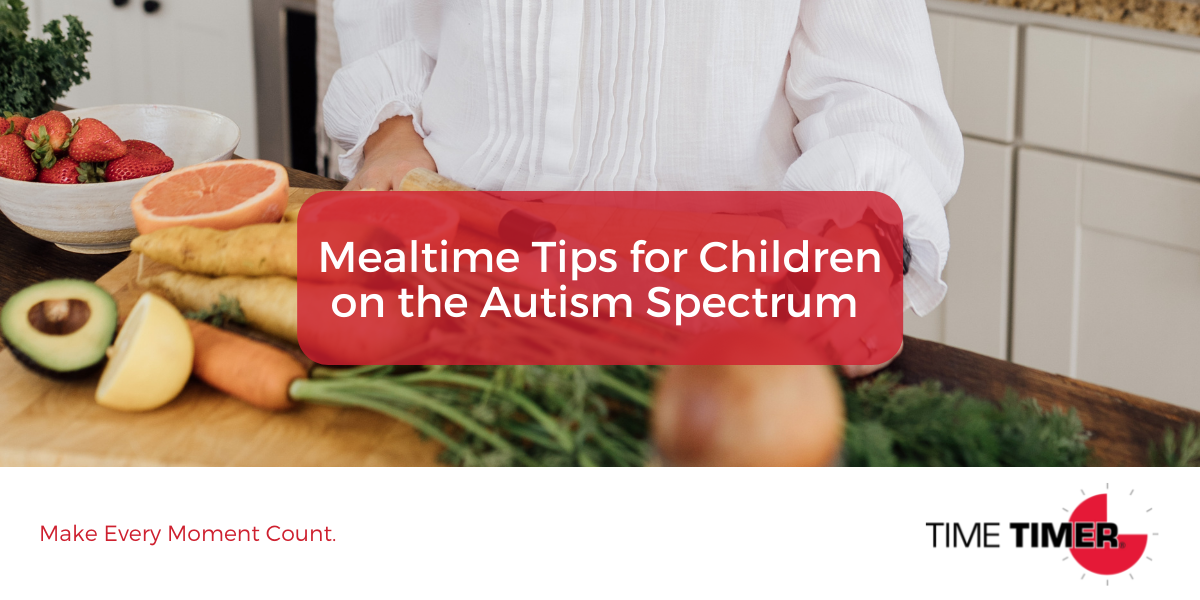Mealtime Tips for Children on the Autism Spectrum
By Brittyn Coleman, MS, RDN/LD, CLT | The Autism Dietitian
For children on the autism spectrum, mealtime can be an incredibly overstimulating experience, making trying new foods challenging.. Since eating is one of our most sensory-rich experiences, trying new foods with new flavors, textures, smells, and colors can quickly become overwhelming. While there are many approaches that ultimately come together to make mealtime successful and positive, one of the most important is creating a positive and consistent mealtime environment for children to feel calm and safe.
Top Mealtime Tips
Here are some of my top mealtime tips as an Autism Dietitian for parents who have children on the Spectrum:
1. Have a consistent mealtime routine: Consistency can go a long way! Every mealtime, consider having a 2 or 3-step routine that you follow every time before you sit down for a meal. For example, you can wash your hands with the Time Timer Wash for 20 seconds, march to the table, and take a few deep breaths, a quick moment of silence, a blessing, or a family ritual. This helps the child’s body and mind prepare for the mealtime ahead for success and help the body be in a “rest and digest” state rather than a “flight or fight” state.
2. Set daily meal and snack times: Having consistent meal and snack times sets the child’s body clock up for success. This not only provides a consistent daily routine for the child, but it can also help improve picky eating if they are coming to meal and snack times with an appropriate hunger instead of grazing throughout the day.
3. Sit in a chair that promotes optimal eating posture: Use a chair that promotes proper mealtime posture, like the Stokke Tripp Trapp! This chair allows utilization of the “90-90-90” position, which means that a child’s hips, knees, and ankles are all at a 90 degree angle. A secure seating position is important for core and head support, better hand-to- mouth coordination, full range of motion in the jaw for chewing, and ideal fine motor control of the food. These are all important factors in helping your child try new foods at mealtime.
4. Use divided plates: A divided plate can help reduce stress around preferred and non-preferred foods touching. Our favorite materials include bamboo, stainless steel, and silicone.
5. Only have 3-4 foods on your child’s plate at a time: Have no more than 3 different foods on your child's plate at a time (some kids may tolerate 4). Only have *one* non-preferred food on your child's plate at a time and make sure you have at least one of their preferred foods!
6. Use manageable amounts: Start small and work your way up! For example: start with one kernel of corn instead of a big scoop. Think of starting with a small amount the size of your pinky fingernail!
7. Avoid distractions: Sensory overload can prevent your child from trying a new food. Turn off the TV, put away the iPad, clean up toys, etc. This may take time if your child currently relies on these to sit at the table, so be patient and take it slow!
8. Utilize food chaining: When you do start introducing foods, introduce foods that are similar in color, texture, and flavor that your child already likes. An approach called "Food Chaining" can be incredibly helpful when coming up with a feeding plan.
All in all, every child is different and will have successes with different approaches! Expanding the diet for kids on the spectrum takes time and can absolutely feel frustrating as a parent when you see slow progress. Working with a dietitian or feeding therapist who is experienced in autism and feeding challenges can help support you in your success! You can also consider online courses like Overcoming Picky Eating for Autism to help you get started.
Follow @AutismDietitian on Instagram for more tips!
About Brittyn:
Brittyn Coleman, MS, RDN/LD, CLT is a Registered Dietitian, Autism Nutrition Expert, and the Creator of the Autism Nutrition Library. She works with parents of children with autism to expand accepted foods for picky eaters and improve gut health by looking deep to find the root causes of their symptoms, and ultimately help them feel their best so that they can thrive. She relates to families on a personal level as her younger brother was diagnosed on the spectrum over 20 years ago. This experience has made her a better healthcare provider and helps her relate and empathize with clients and their families.


